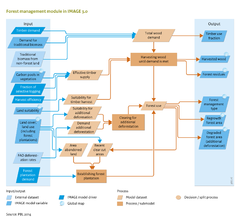Forest management: Difference between revisions
Jump to navigation
Jump to search
No edit summary |
Oostenrijr (talk | contribs) m (Text replace - "km2" to "km<sup>2</sup>") |
||
| Line 9: | Line 9: | ||
|Parameter=Traditional biomass from non-forest land; FAO deforestation rates; | |Parameter=Traditional biomass from non-forest land; FAO deforestation rates; | ||
|OutputVar=Timber use fraction; Forest residues; Forest management type - grid; Regrowth forest area - grid; Harvested wood; Degraded forest area; | |OutputVar=Timber use fraction; Forest residues; Forest management type - grid; Regrowth forest area - grid; Harvested wood; Degraded forest area; | ||
|Description=The global forest area and wooded land area has been estimated for 2010 at just over 40 and 11 million | |Description=The global forest area and wooded land area has been estimated for 2010 at just over 40 and 11 million km<sup>2</sup>, respectively ([[FAO, 2010]]). Forest resources are used for multitude of purposes, including timber, fuel, food, water and other forest-related goods and services. In addition, (semi-) natural forests are home to many highly valued species of interest for nature conservation and biodiversity. | ||
The total global forest area is continuing to decline at difference rates in different world regions. Although the rate of global deforestation has decreased in the last decade, deforestation is still occurring on a significant scale in large parts of Latin America, Africa and Southeastern Asia. At the same time, the net forest area is expanding in some regions, such as in Europe and China ([[FAO, 2010]]). Sustainable management of global forest resources may contribute to preserving forests, slowing down or reversing degradation processes, and conserving forest biodiversity and carbon stocks ([[FAO, 2010]]). | The total global forest area is continuing to decline at difference rates in different world regions. Although the rate of global deforestation has decreased in the last decade, deforestation is still occurring on a significant scale in large parts of Latin America, Africa and Southeastern Asia. At the same time, the net forest area is expanding in some regions, such as in Europe and China ([[FAO, 2010]]). Sustainable management of global forest resources may contribute to preserving forests, slowing down or reversing degradation processes, and conserving forest biodiversity and carbon stocks ([[FAO, 2010]]). | ||
| Line 15: | Line 15: | ||
Several types of forest management systems are employed in meeting the worldwide demand for timber, paper, fibreboard, traditional or modern bioenergy and other products. Management practices depend on forest type, conservation policies and regulation, economics, and other, often local, factors. Practices differ with respect to timber volume harvested per area, rotation cycle, and carbon content and state of biodiversity of the forested areas. | Several types of forest management systems are employed in meeting the worldwide demand for timber, paper, fibreboard, traditional or modern bioenergy and other products. Management practices depend on forest type, conservation policies and regulation, economics, and other, often local, factors. Practices differ with respect to timber volume harvested per area, rotation cycle, and carbon content and state of biodiversity of the forested areas. | ||
Modelling of forests and forest management is an integral part of the IMAGE 3.0 framework, with a simulated forest area in 2010 at about 46 million | Modelling of forests and forest management is an integral part of the IMAGE 3.0 framework, with a simulated forest area in 2010 at about 46 million km<sup>2</sup> , somewhat larger than observed by {{abbrTemplate|FAO}} as this area includes fractions of other wooded land (see Component [[Carbon cycle and natural vegetation]]). To manage these forests, three forest management systems are defined in IMAGE 3.0 in a simplification of the range of management systems implemented worldwide ([[Carle and Holmgren, 2008]]; [[Arets et al., 2011]]). | ||
# The first forest management system is clear cutting or clear felling, in which all trees in an area are cut down followed by natural or ‘assisted’ regrowth, as widely applied in temperate regions. | # The first forest management system is clear cutting or clear felling, in which all trees in an area are cut down followed by natural or ‘assisted’ regrowth, as widely applied in temperate regions. | ||
# The second forest management system is selective logging, in which only trees of the highest economic value are felled, commonly used in tropical forests with a high heterogeneity of tree species. An ecological variant of selective logging is reduced impact logging ({{abbrTemplate|RIL}}) directed to reducing harvest damage, stimulating regrowth and maintaining biodiversity levels ([[Putz et al., 2012]]). | # The second forest management system is selective logging, in which only trees of the highest economic value are felled, commonly used in tropical forests with a high heterogeneity of tree species. An ecological variant of selective logging is reduced impact logging ({{abbrTemplate|RIL}}) directed to reducing harvest damage, stimulating regrowth and maintaining biodiversity levels ([[Putz et al., 2012]]). | ||
Revision as of 10:40, 1 July 2014
Parts of Forest management
| Component is implemented in: |
| Components: |
| Related IMAGE components |
| Projects/Applications |
| Key publications |
| References |
Key policy issues
- How can management influence forest capacity to meet future demand for wood and other ecosystem services?
- What are the implications of forest management for pristine and managed forest areas, and on biomass and carbon stocks and fluxes of relevance for climate policy?
- What are the prospects for more sustainable forest management and the role of production in dedicated forest plantations?
